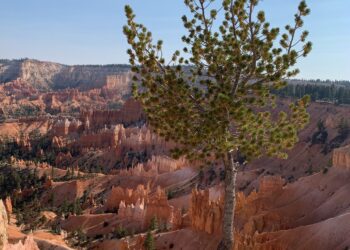By Kyle Roerink WRITERS ON THE RANGE

Seven Western states and their leaders—all depending on water from the Colorado River—remain divided.
Split into basins by an imaginary border at Lees Ferry, Arizona, each state can share blame for the rapid depletion of reservoirs that once held over four years’ flow of the Colorado River. But now, Lake Powell and Lake Mead edge closer to empty. With water savings gone, the Lower Basin has been trying to cope, though the Upper Basin carries on business as usual. Meanwhile, 40 million Americans depend on flows from this over-diverted river.
So far, leaders in the Upper Basin states of Colorado, New Mexico, Utah and Wyoming appear to be hoping that their counterparts will agree to use less water. This is hardly a useful strategy and seems a lot like a dangerous game of chicken.
The brunt of low flows has been borne by the Lower Basin states of Arizona, Nevada and California. Thanks to a series of agreements between 2007 and 2021, by the end of this year the three states will curtail their river use by more than 1 million acre-feet—325 billion gallons. But it’s likely these cuts won’t change much.
Federal data released last month predict that Lake Mead, the largest reservoir in the nation and the Lower Basin’s water savings account, will continue to lose water for years to come. Lake Powell, the Upper Basin’s savings account, is also vulnerable. But that raises the obvious question: What are Colorado, Wyoming, Utah and New Mexico doing to limit their water use and conserve? The answer is not much.
In the Upper Basin’s four states there are no self-imposed curtailments of Colorado River allocations—no blockbuster, big-city conservation initiatives, no real signs that leaders are convinced that climate change is not only happening but also a major threat to the region.
More discouraging is that in 2016, the interstate collective of Upper Basin officials, known as the Upper Colorado River Commission, officially decided to take more water out of the river. That decision stands today.
Some of the largest projects on the Upper Basin’s wish list include the Lake Powell Pipeline, Green River Block Exchange, Wolf Creek Reservoir, and the Fontenelle Dam expansion. These proposed projects would drain billions of gallons from the system, reports the nonprofit Save the Colorado.
Does anyone think that extra water exists?
The Bureau of Reclamation, which manages the Colorado River’s infrastructure, released a report in mid-February that predicts Lake Mead will drop another 30 feet by the end of 2023––leaving the reservoir 160 feet lower than in the year 2000. It also predicts more cuts for Nevada’s and Arizona’s shares of the river, as well as for California.
In the Upper Basin, where the Colorado River begins, no cuts are proposed. And according to a new report from the Utah River’s Council, a nonprofit fiscal and water watchdog, most of the Upper Basin states continue to use more than their share of the river, even though drought and aridity have reduced river flows.
While the three Lower Basin states use more water than the drought-stricken Colorado can deliver annually, leaders in Arizona, Nevada and California share a spirit of sacrifice when it comes to limiting water use. From my experience running a nonprofit river-protection group, I know that collaboration toward these efforts represents a resolve to act.
The Lower Basin states, for example, are working to fund a water-recycling facility near Los Angeles. The plant would reduce California’s reliance on the Colorado River and give Nevada and Arizona some of that river water in return for their joint funding. Collaborations like this need to start happening in the Upper Basin, but where are the examples?
Water managers in both basins tell folks they are doing their best to deal with the river’s decline, but only the Lower Basin’s actions can be quantified. It’s time for the Upper Basin to blink in this game of chicken and ensure equitable and prudent uses of the river. The lines dividing the states are invisible, but bathtub rings on Lake Powell and Lake Mead are all too visible.
Kyle Roerink is a contributor to Writers on the Range, writersontherange.org, a nonprofit dedicated to spurring lively conversation about the West. He is the executive director of the Great Basin Water Network, a nonprofit that defends water supplies from undue political and corporate influence in the nation’s two driest states, Nevada and Utah.















